Overview of Recent Innovations in UK Automotive Safety
Recent UK automotive safety advancements reflect a strong focus on integrating sophisticated technologies tailored to local driving conditions and regulatory demands. Among the latest automotive safety technologies, adaptive systems leveraging artificial intelligence and real-time data analysis have gained prominence. These innovations address prevalent causes of accidents such as driver distraction and adverse weather.
Key automotive safety trends UK emphasize the widespread adoption of smart sensor arrays that enhance collision avoidance and pedestrian detection. Additionally, innovations in vehicle-to-vehicle (V2V) communication enable cars to share critical safety information, reducing crash risks in densely trafficked urban areas.
Also to see : What role does AI play in enhancing UK automotive safety features?
UK-specific factors, including road layouts and stringent safety standards, drive these developments. Regulatory frameworks mandate the progressive inclusion of active safety features, pushing manufacturers to prioritize technologies like lane-keeping assist and automated emergency braking. This synergy of regulation and technology fosters safer road environments across the UK, with continuous research aimed at refining these systems to adapt to evolving transport challenges.
In essence, the landscape of UK automotive safety is rapidly evolving, with interconnected innovations designed to reduce accidents and enhance driver protection. These advancements mark a significant step in modernizing vehicle safety to meet the needs of UK drivers and pedestrians alike.
Also read : Can Electric Cars Truly Transform Urban Mobility in the UK?
Smart Safety Technologies: Present Transformations
Delving into current technological shifts
Advanced driver-assistance systems (ADAS) UK represent a cornerstone of recent UK automotive safety advancements. Designed to mitigate human error, these systems include features like adaptive cruise control and lane departure warnings, improving real-time driver awareness. One particularly important technology within this scope is autonomous emergency braking (AEB), now widely integrated into UK vehicle safety features. AEB automatically slows or stops vehicles when collision risk is detected, significantly reducing rear-end crashes.
Connected vehicle technology enhances these systems by enabling communication between vehicles and infrastructure. This allows quicker hazard recognition and coordinated responses, reflecting key automotive safety trends UK towards a more networked driving environment.
UK manufacturers have progressively adopted these innovations, driven by regulatory pressures and consumer demand. Case studies demonstrate notable reductions in accident rates where ADAS and AEB have been deployed, underscoring their practical benefits. Collectively, these latest automotive safety technologies contribute to safer roads by combining autonomous interventions with smarter connectivity, tailored to the UK’s unique traffic conditions. This dynamic evolution ensures continuous improvement in vehicle safety performance across the country.
Government Initiatives and Regulatory Influence
Safeguarding UK roads through policy and standards
The UK government automotive safety initiatives play a pivotal role in shaping the landscape of vehicle safety. Recent car safety regulations UK mandate the integration of advanced systems such as autonomous emergency braking and lane-keeping assist in all new vehicles, elevating the baseline for standard safety equipment. These regulations reflect evolving industry standards UK, promoting higher safety benchmarks and reducing road casualties.
Government programs actively incentivise manufacturers and consumers to adopt cutting-edge technologies. For instance, grants and tax benefits encourage the uptake of vehicles equipped with the latest automotive safety technologies. This approach accelerates deployment and fosters innovation within the automotive sector.
Policy influence extends beyond mandates, driving industry-wide commitment to safety through collaborative frameworks. By aligning regulatory demands with technological progress, the UK ensures continuous improvement in UK automotive safety advancements. Ultimately, these initiatives create a safer driving environment by integrating legal imperatives with practical technology solutions tailored to UK road culture and conditions.
Industry Leaders and Collaborative Developments
The UK automotive industry leaders play a crucial role in advancing vehicle safety through robust innovation. Companies like Jaguar Land Rover and Aston Martin have integrated several latest automotive safety technologies into their models, pushing the envelope on accident prevention and driver assistance.
Collaboration is another vital component. Cross-sector automotive technology collaboration UK brings together manufacturers, technology firms, and universities to accelerate the development of advanced safety systems. These partnerships focus on improving sensor accuracy, real-time data processing, and vehicle-to-everything communication—key areas aligned with current automotive safety trends UK.
Several pilot programmes demonstrate the strength of such cooperation. For example, joint projects funded by government and industry are testing enhanced pedestrian detection systems and smart infrastructure connectivity. These initiatives show promising results, indicating greater potential for reducing collisions in urban environments.
By fostering such safety innovation partnerships, the UK solidifies its position as a leader in automotive safety research and deployment. The synergy between established manufacturers and emerging tech companies ensures that innovations reach the market efficiently, benefiting UK drivers and pedestrians alike.
Future Trends and Prospective Safety Technologies
Envisioning the next steps in vehicle protection
Research into future automotive safety UK focuses heavily on emerging technologies designed to revolutionize road safety. Among these advances are fully autonomous driving systems, which aim to eliminate human error by combining precise sensors, AI, and machine learning. Extensive UK vehicle safety research is addressing challenges in urban environments, including complex pedestrian and cyclist interactions.
Emerging automotive safety technologies also include enhanced V2X (vehicle-to-everything) communication, allowing vehicles to anticipate hazards through data shared with infrastructure and nearby cars. This networked approach promises quicker, more coordinated responses in critical situations, a key progression from current automotive safety trends UK.
Prospective systems incorporate predictive analytics to assess real-time risk, adapting vehicle behaviour proactively. Such developments forecast substantial reductions in collision rates and severity, potentially transforming UK road safety culture.
Ongoing trials and pilot studies validate these innovations, ensuring practical application aligns with regulatory goals. As future automotive safety UK evolves, combining smart technology with rigorous research will underpin safer, more efficient driving experiences throughout Britain.



